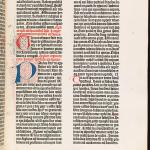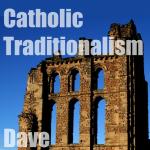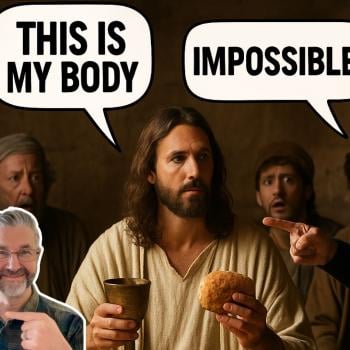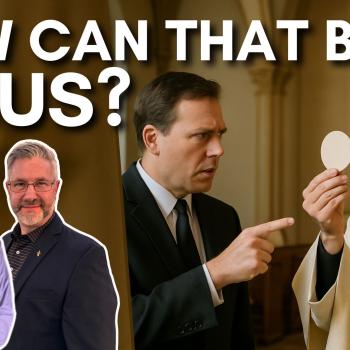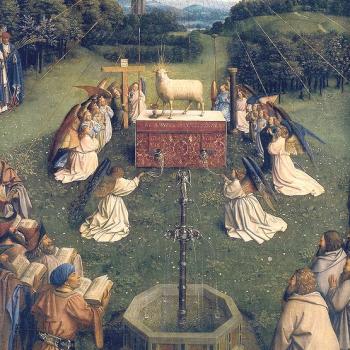
This is a follow-up exchange, related to my recent dialogue, Debate: Teach & Enforce Liturgical Rubrics Or No? Pete Vere is a canonist and Catholic author, blogger, ecumenist, and sometimes-apologist. His words will be in blue. A second person (who requested anonymity) has extensive canon law training and also a degree in philosophy. His words will be in green.
*****
The Latin legal mindset is a lot different than the American legal mindset. Especially when it comes to Church matters. Americans tend to be much more literalist given America’s Calvinist, Fundamentalist, and English common law roots.
Whereas the Roman legal mindset is to have few laws that are “hard and fast” (those governing Transubstantiation would be an example) while most other laws are more like “suggestions” with various degrees of weight, best implemented and interpreted through local custom.
As Fr Angel Sotelo points out above–no doubt drawing upon his canon law class as a seminarian–when enough people in enough parishes over a long enough period of time do something that is not accounted for in the rubrics, or even is contrary to the rubrics (provided it is not invalidating or immoral), then a new custom (or counter-custom) arises. Eventually this takes the force of law.
This is not against canon law since, within the Latin legal mindset upon which canon law in both East and West is built, the law must be free to breathe and grow organically in response to the needs and practices of those who are governed by it.
With the Latin mindset, the Law must be able to breathe, for the most part is flexible to application, and is best interpreted through local custom.
What we see here is a spontaneous custom that has arisen in parts of the Latin Church following the Second Vatican Council. Many laity seem to like it, and nobody is harmed by it, so likely it is here to stay regardless of whether or not it is included in the rubrics.
Why is it, then, that almost invariably, the altar servers will hold their hands together by their stomachs, rather than raise them during the Our Father? If they can and do learn the proper procedure, why can’t the congregation? Conversely, if it is no big deal, why don’t they join in with everyone else? Why are they taught to do that in the first place? Just let them be “spontaneous” . . .
Father Angel is not saying the same thing you are. He is saying, “I still discourage hand holding and orans, but my parishioners visit other places where the priest told them I was wrong.” He’s saying that not every hill is worth dying on: which I have agreed is understandable from the parish priest’s perspective. He said, “don’t do x” and some did, anyway, so he has decided to let it pass (like parents also do in many situations, exercising prudence). But he did instruct them as to what they should do. He also noted that popes okayed two particular things. That’s quite different from parishioners starting to do whatever they feel like doing.
You are saying something very different: in effect, “who cares? Romans [unlike Calvinist-influenced Americans] are flexible with law . . .” I say that your way could eventually potentially produce chaos. There could be any number of things that parishioners “spontaneously” start doing during Mass (just like millions of Catholics have spontaneously done with moral rules like no contraception or cohabitation). What if they feel the need to hold hands and march around the entire room seven times: sort of like a wedding reception-type dance or Jewish dances? Or to start a 15-minute “mini-social” at the sign of peace? “How’s little Susie doing with her ballet lessons?” “Seen any good movies lately?” Etc.
What if they feel “led” to enter into spontaneous prayer for ten minutes (which is what would often happen in the Assemblies of God churches that I used to go to: with tongues, of course, and sometimes “prophecies”)? To use a reductio ad absurdum, say they start wanting to stand on their head at a certain point in the Mass, or jump up and down, turning around?
According to you, as long as it is a “spontaneous custom” there is no argument (it seems to me) that could be made against it. It’s democracy in the classic sense: mob rule. But even you draw a line at some point: where such things wouldn’t apply: “for the most part is flexible to application” [my italics]. So now the discussion would be where that line is?
There obviously is some reason why the rubrics exist. If we simply thumb our noses at it, then that is the Protestant mindset: collapsing every liturgical rule and formal law into an undesirable legalism, that goes against rugged American individualism (since you once again insist on making this an “American” thing, as usual). It’s the sort of mindset that thinks all formal worship is “dead and legalistic and pharisaical”: “vain repetition” etc.
That is exactly how I used to think, because I was extremely unliturgical (low church / Arminian / Jesus People-style of informal worship). When I became a Catholic, I accepted that the Church in her wisdom has a certain liturgy (where each rite has rules and a procedure followed) and liturgical rules for a good purpose, and that they ought to be followed. I accepted the notion that the Church knows far better than I do as an individual, because she is the Guardian of tradition: both doctrinal and liturgical, and possesses the accumulated spiritual wisdom of the ages.
As Chesterton noted: tradition is the “democracy of the dead.”
The Church in her wisdom has liturgical rubrics. She also, in her wisdom, preserves the Latin mindset in her understanding and approach to law, which includes a healthy reverence for local custom.
. . . which is merely repeating the same thing you said, now for the third time, rather than interacting with what I said.
What Pete said is right when it comes to interpreting the law. Are you seriously going to go to a country in South America, see that this has been the custom in that parish for the last 40 years, and tell them “Don’t do it!”? I would suggest taking a course in canon law.
You also don’t interact with what I argued. Is it so difficult to do?
Do the rubrics actually state: “But if the congregation spontaneously does something different from what is required here, just let them do it as a matter of local custom, and don’t worry about it”? Maybe it does. That would be a solid, objective argument, since it would be in the rubrics itself.
I’ve been trained by the best canonists in Rome, trained by the late great Eugenio Corecco. What Pete says about the law is right. It would take a long time to actually engage with what you said. For starters: Canon 27: Custom is the best interpreter of laws.
Now this is interesting:
BOOK I. GENERAL NORMS
TITLE II.
CUSTOM (Cann. 23 – 28)
Can. 23 Only that custom introduced by a community of the faithful and approved by the legislator according to the norm of the following canons has the force of law.
Can. 24 §1. No custom which is contrary to divine law can obtain the force of law.
§2. A custom contrary to or beyond canon law (praeter ius canonicum) cannot obtain the force of law unless it is reasonable; a custom which is expressly reprobated in the law, however, is not reasonable.
Can. 25 No custom obtains the force of law unless it has been observed with the intention of introducing a law by a community capable at least of receiving law.
Can. 26 Unless the competent legislator has specifically approved it, a custom contrary to the canon law now in force or one beyond a canonical law (praeter legem canonicam) obtains the force of law only if it has been legitimately observed for thirty continuous and complete years. Only a centenary or immemorial custom, however, can prevail against a canonical law which contains a clause prohibiting future customs.
Can. 27 Custom is the best interpreter of laws.
Can. 28 Without prejudice to the prescript of can. 5, a contrary custom or law revokes a custom which is contrary to or beyond the law (praeter legem). Unless it makes express mention of them, however, a law does not revoke centenary or immemorial customs, nor does a universal law revoke particular customs.
How would that specifically relate to liturgy and the rubrics?
And it does mention approval of a “legislator” (at least to have the “force of law”). So now we have priests approving of it (most) and others who don’t (a minority)?
I don’t mean to be mean to say this, but it would be good for you to take a course on canon law. None of what Pete said is controversial. You’re not going to get anyone in the Vatican who is going to tell people in South America to stop doing it because “it is against the rubrics.”
Colin B. Donovan, STL expressed a view similar to what I said above about the altar servers:
Our Father. The intention for lay people using the Orans position at this time is, I suppose, that we pray Our Father, and the unity of people and priest together is expressed by this common gesture of prayer. Although this gesture is not called for in the rubrics, it does at least seem, on the surface, to not be in conflict with the sacramental sign system at the point when we pray Our Father. I say on the surface, however, since while lay people are doing this the deacon, whose postures are governed by the rubrics, may not do it. So, we have the awkward disunity created by the priest making an appropriate liturgical gesture in accordance with the rubrics, the deacon not making the same gesture in accordance with the rubrics, some laity making the same gesture as the priest not in accordance with the rubrics, and other laity not making the gesture (for various reasons, including knowing it is not part of their liturgical role). In the end, the desire of the Church for liturgical unity is defeated.
After Our Father. This liturgical disunity continues after the Our Father when some, though not all, who assumed the Orans position during the Our Father continue it through the balance of the prayers, until after “For thine is the kingdom etc.” The rubrics provide that priest-concelebrants lower their extended hands, so that the main celebrant alone continues praying with hands extended, since he represents all, including his brother priests. So, we have the very anomalous situation that no matter how many clergy are present only one of them is praying with hands extended, accompanied by numbers of the laity. (Orans Posture (“Praying” Hands Extended); all bolding and italics in original )
Yeah, I read Colin Donovan’s article too when I was in high school…then I actually learned canon and liturgical law. Anyway, it’s not a controversial issue. For example, it is not in the rubrics that people who is in a state of mortal sin or non-Catholics come to the communion line to be blessed by the priest or deacon. But that could be a custom as well, and Pope BXVI even said that could be an answer to divorce and remarried people. Again, not controversial. To close the issue, the USCCB said that there is no prescription on what should be done during the Lord’s Prayer.
But this approach toward local custom has always been the Church’s approach. You ask what’s to stop laity from going rogue and ruling through democratic mob?
The bishops and the Patriarchs. This too is an evolution from ancient Roman law and the Latin legal mindset, in which each “head of household” (pater familias) oversees how the law is implemented and observed in his own household, according to the needs of his family.
The USCCB says, “No position is prescribed in the Roman Missal for an assembly gesture during the Lord’s Prayer.” So custom should be honored here unless the bishop has given a liturgical law in his diocese about this issue.
If we’re gonna “play canon lawyer” then I could produce the words of Dr. Edward Peters:
[W]ith a few important exceptions, Canon law generally does not treat liturgical matters. But if liturgical law is not found in canon law, where does one look for it? . . .
Today, in order to answer confidently any but the most doctrinally core questions about liturgical practice, one must have access to and a command of:
The 1983 Code of Canon Law and its subsequent authentic interpretations;
The official texts of the Rites and their latest approved translations, including all current curial instructions on same (issued by whatever dicastery, no matter how or where published);
Negative proof that no Vatican indults or privileges affecting the above have been issued (and, if issued, not expired or revoked);
National episcopal conference liturgical legislation (or other conference publications which often end up being treated as legislation), knowing to what degree these might have required, and received, Vatican approval, again not revoked or expired.
Various arch/diocesan liturgical policy statements (unless they’re called guidelines, in which case they might or might not be treated as particular law);
Commentaries on any of the above, to the degree they might be useful and reliable; to say nothing of the multitudinous practices of individual liturgists, priests, and pastors, who might or might not defer all liturgical issues to their liturgy committees, whatever their qualifications might be.
The Problem Really Is the System
If this all sounds maddening, it is.
But by the same token, it goes a long way toward explaining why so many pew Catholics (though for that matter many Church officials as well) feel bewildered in their attempts to find out what licit liturgical practice currently is, and why so many laity in particular are simply overwhelmed in, their efforts to protect themselves against liturgical abuse. (“Liturgical Law: The Last Labyrinth”)
This was published in Adoremus Bulletin (Sep 1996). Did you read this one while you were in high school too? I have no interest in taking a canon law course. That’s why I’m trying to get answers from you guys who have done so.
And I highly doubt that everything is so simple and clear-cut as you claim, when you have someone like Fr. Peter Stravinskas who disagrees regarding orans and hand-holding. You can hardly argue that he is just a dummy, over his head. Jimmy Akin is no slouch, either. They were my two main sources in my previous articles on the topic. Here’s my most in-depth one. I cited Dr. Edward Peters in my paper also:
While the orans position as such has a rich tradition in Jewish and even ancient Christian prayer life, there is no precedent for Catholic laity assuming the orans position in Western liturgy for at least a millennium and a half; that point alone cautions against its introduction without careful thought. Moreover — and notwithstanding the fact that few liturgical gestures are univocal per se — lay use of the orans gesture in Mass today, besides injecting gestural disunity in liturgy, could further blur the differences between lay liturgical roles and those of priests just at a time when distinctions between the baptismal priesthood and the ordained priesthood are struggling for a healthy articulation. (“Another Look at the Orans Issue”, 2-27-15)
My point still holds that postures, symbols, and practices can evolve or even change meaning over the years to account for differences in culture, geography, or historical circumstance. Otherwise, Latins would still be prohibited from kneeling during Mass or receiving Holy Communion under the species of bread alone.
At the very least, different “experts” are saying different things, and it is not so marvelously simple as you two make out. If you wanted to appeal to the authority of canon law, I only had to go to Ed Peters to find a canonist who appears to disagree with you. And that’s not good. There should be perfect clarity about such things, rather than confusion. Dr. Peters argues that the situation with regard to liturgy is unacceptably confusing.
What you need to remember is that ultimately the experts are not liturgists, canonists, or theologians, but the bishops and Patriarchs.
It’s not that difficult. I personally don’t do it and I think we should be cautious as well, partly for the same reasons Peters said. However, Canon 27 is important especially when the USCCB says there is no prescription on the gestures of the faithful during the Lord’s Prayer. In other words, if this is what you see in a parish, you don’t go around saying, “The rubrics are against this! You shouldn’t do this!” This applies equally well when you go to another country.
I don’t go around berating people in person about it (not my “style” or temperament at all, as anyone who knows me in person, knows). I simply report what I can determine, according to the best sources I can find. I don’t think Fr. Stravinskas and Jimmy Akin and Karl Keating and Dr. Ed Peters are bad sources. They could possibly be wrong, of course, but that doesn’t make them “bad” sources or make me sloppy and irresponsible in my research on the topic.
A non-expert can still make a valid observation that should be answered. I raised the point about the anomalies between altar servers’ posture and that of the congregation. Colin Donovan (canonist or no) makes the same point. Both of you ignored it: along with many other aspects of my argument. But it’s a perfectly reasonable question to ask (because the current situation makes no sense). If altar boys and girls are taught proper posture, why can’t congregations also be so taught?
This is the kind of thing the non-expert and non-canonist and non-liturgist like myself observes. I’m not a big fan of contradiction and mixed signals. We’re just out here in the pews trying to figure out what the hell is going on.
They aren’t bad sources. However, they are from one particular country and represent one particular school of thought.
Catholicism is universal. Which is why it is important to get a broad perspective of how Catholics throughout the world approach the issue. Especially on an issue as broad as liturgical custom.
Notice that [Name] and I pretty much shared the perspective of those you cite until I studied canon law (including starting a doctorate in liturgical custom, which I never finished) while [Name] broadened his perspective after studying in Rome with students from around the world.
Now you’re appealing to [canonical] authority again. Ed Peters is also a canonist and he disagrees with you, far as I can tell.
There are elements of this discussion that I find highly amusing. Here you two were highlighting that only canonists really understand the issue, and that I should take a course in canon law to get up to speed. I was directed to Canon 27, as if that was the knockout punch that should end the discussion (me surrendering in blissful non-canonical ignorance).
So (in my admitted non-expertise concerning canon law) I asked a perfectly reasonable question: “How would that specifically relate to liturgy and the rubrics?” And then canon law was appealed to again and it was stated that “None of what Pete said is controversial.”
But then enter canonist Ed Peters who says: “[W]ith a few important exceptions, Canon law generally does not treat liturgical matters.”
!!!! LOL
Thus, we have a scenario where you guys keep appealing to canon law as regards a liturgical controversy, while canonist Peters says that canon law scarcely deals with liturgy at all. And we “laymen” are supposed to sort all that out? It’s needle in a haystack stuff.
That said, I go back to what I said above: “At the very least, different “experts” are saying different things, and it is not so marvelously simple as you two make out.” Now, I grant, that maybe I have made the issue simpler than it is, too. But I don’t claim to be a liturgical expert. You two do (by making canon law the supposed determiner of the rubrics). I think you shouldn’t go around saying it is such a simple matter when it clearly is not, by any reasonable criterion. Bishops, priests, canonists, and liturgists are having serious disagreement about it.
Meanwhile, those of us in the pews, not possessed of all this wonderful canonical or expert liturgical knowledge, are still trying to figure out what the hell is going on, and what the proper posture during Mass is.
I would say (for what it’s worth) that it seems that a stronger case can be made against the orans posture (because it is a priestly one) than hand-holding.
But in terms of the orans posture while praying?
Late 70’s/ early 80’s Catholicism in Canada and the U.S. and parts of western Europe where Catholics were being taught or led to believe there’s no ontological difference between laity and clergy, and the Eucharist is just a mere symbol?
Bad idea. Reinforces bad theology.
But today, I see it more akin to kneeling in the historical development of the Latin rite. The faithful like this posture because it feels reverent while praying the Pater Noster just before receiving Holy Communion. So far from signalling bad theology, it reinforces the reverence felt by the average layperson towards the Lord’s Prayer and the Eucharist.
Same posture, but completely different meanings.
Yeah, the Code of Canon Law generally does not deal with liturgical law because liturgical law is an area of the law that requires its own experts.
However, liturgical law is still generally subject to General Norms (the first of seven books in the 1983 Code of Canon Law), which includes the above-cited canons on custom.
But that hardly decides the issue, because it still has to be dealt with in specificity. A general norm cannot resolve a particular problem. Thus, appeal to that is not the knockout punch that you two seemed to think it was.
Actually, a general norm can resolve a particular problem. General norms are the general principles of canon law to which all other canons are subject in their interpretation and application.
As for those in the pew without degrees in liturgy or canon law (including many Catholic apologists who enjoying weighing in the issue), the best thing is to look towards the local bishop. (Provided the proposed practice is not contrary to the natural law or divine positive law. So, for instance, you could never have a custom arise in which the priest blesses a woman about to abort her child.)
It may surprise you to hear me say this, but I actually think it is a relatively minor issue in the overall scheme of things. But I think that it still is an issue that deserves to be clarified, so as to lessen confusion. I don’t think that it is “nothing” or a “trifle”: as some of my critics (not you two) think.
It’s not like I am dogmatic about these things. I don’t lay awake at night condemning everyone who does orans during the Our Father. I’m not a judgmental person. I think, “they are doing a pious act — harmless in and of itself — ; they simply need to be better instructed on the rubrics: and that is the fault of their would-be teachers, not them.”
I would only add: you can’t say “they simply need to be better instructed on the rubrics” since they are not breaking any according to the USCCB.
It’s only confusing if one is trying to argue a universal application across the Roman Rite.
If anyone wants to know what the local answer is, I would urge you to get in touch with the diocesan liturgical committee. They can clarify how it is to be implemented in one’s diocese.
I assume that is indicated in actual practice: it’s done everywhere except in a liturgically traditional parish (OF) like I used to attend or where the EF is celebrated.
But this is the closest I got. I could find nothing about posture during the Our Father or orans. And I fully expected that I wouldn’t find any clarification. This is how it goes.
And you wonder why laypeople and non-liturgists and non-canonists enter into these sorts of topics? It’s usually by default, because people are so uninformed: not having been properly catechized and taught by the Church and her authorities.
The Holy See has been concerned about the laity unduly aping the priest at Mass, and in the 1997 Instruction on Collaboration, an unprecedented conjunction of Vatican dicasteries wrote:
6 § 2. To promote the proper identity (of various roles) in this area, those abuses which are contrary to the provisions of canon 907 [i.e., “In the celebration of the Eucharist, deacons and lay persons are not permitted to say the prayers, especially the eucharistic prayer, nor to perform the actions which are proper to the celebrating priest.”] are to be eradicated. In eucharistic celebrations deacons and non-ordained members of the faithful may not pronounce prayers — e.g. especially the eucharistic prayer, with its concluding doxology — or any other parts of the liturgy reserved to the celebrant priest. Neither may deacons or non-ordained members of the faithful use gestures or actions which are proper to the same priest celebrant. It is a grave abuse for any member of the non-ordained faithful to “quasi preside” at the Mass while leaving only that minimal participation to the priest which is necessary to secure validity.
This instruction, incidentally, was approved by John Paul II in forma specifica, meaning that the pope invested it with his own authority and is binding on us with the pope’s authority and not merely the authority of the authoring congregations.”
Now, what gestures are proper to the priest celebrant? The orans gesture when praying on behalf of the people is certainly one of them.
Does a pope and a saint (and as a bonus, a non-American Pole, too!) have “canonical authority” to decide such a thing? And how does this not rule out the orans posture for the congregation? You tell me. I’m all ears.
This was all in my first paper on the topic, written in July 2008. Now I would appreciate interaction with it, for a change.
I think you got the main gist of custom and it’s importance to liturgical law when you stated these little differences don’t keep you up at night, you understand most folks are acting out of an inner sense of piety or reverence, and yourself adapt to your surroundings when visiting other parishes. This is truly the spirit of Catholicism.
Back then I recall priests inviting deacons and laity (often children) to gather around the altar with the priest during consécration and raise their hands in the Oran’s and recite the prayers with the priest. Obviously this was causing confusion, especially among the minimally catechized. It looked like concelebration.
On the other hand, the Oran’s during the Our Father usually involves laity staying in the pew, thus eliminating the appearance of concelebration and ensuing confusion.
And you continue to just mostly talk past me: now completely ignoring what Pope St. John Paul II stated about orans. You can ignore that if you like (as both of you have been ignoring many of my arguments), but that won’t impress my readers: I’ll guarantee that, because I submit that they would have many of the same questions I do, and would love to see at least some attempted answers to them.
Again, Pete is right. The same document speaks about performing actions that would make it seem like the lay faithful are “quasi presiding”. Holding hands does not show any confusion about who is presiding or that the laypeople are somehow presiding over the eucharistic prayers. Again, when the bishops themselves say there are no prescriptions, there are no prescriptions. This even means that a priest cannot tell someone “You SHOULD hold hands.” And you cannot say “You SHOULD NOT” since the are no prescriptions either. And there is the question about what actions are proper to the priest especially since the Lord’s Prayer has become a prayer with the faithful and not for the faithful. But whatever interpretation you have, the USCCB and the bishops of their dioceses have the final word.
The argument from Pope John Paul II was applied by Jimmy Akin (and myself, by implication) to orans in particular. What do you think of it? You deny that JPII would be forbidding (by his endorsement) orans during the Our Father in that statement?
He isn’t forbidding it and the USCCB’s interpretation is that he isn’t either. It is an interpretation of Can 907 (if my memory serves), which wanted to distinguish between the priest and the faithful. So the eucharistic prayers, taking the cup, etc. are gestures of the priest. Standing or orans during a prayer when the priest is not praying for the faithful is not a gesture particular to the priest. Again: when it comes to liturgical laws, we follow the bishops. By the way, Rome knows that the faithful do this all over the world too. She hasn’t said anything for a reason.
I accept Ed Peters’ canonical interpretation. He has quite impressive credentials. Thanks for the interaction.
Ed Peters doesn’t say it forbids it. He even disagrees with the current law about the priest using the orans. So that’s a disagreement with the law, which he has the right to do. It doesn’t mean that that is what the law says. His wording, if you read it, is careful.
What he’s saying — at a minimum — for sure is that things are confusing, and ought not to be, whereas you and Pete seem to think everything is fine, and “where’s the beef? It’s just American Calvinist- and English law-influenced over-legalism . . . ”
He calls laity doing the Orans posture at the Our Father “On the list of ecclesiastical matters urgently needing attention” and “odd.” That is hardly your position (which is “go with the flow”). Here is what he wrote about it on 27 February 2015:
On the list of ecclesiastical matters urgently needing attention these days, the odd practicing of laity using the orans gesture during the Our Father (and in turn that gesture’s morphing into a rite of hand-holding, often aisle-filling, discombobulation) is, I grant, fairly low in priority. Nevertheless, the orans issue has come to my attention twice recently, and neither time has the author in question seemed aware of the analysis of this issue that I first offered back in 2005. My feelings aren’t hurt, it’s just that, I wonder why more people don’t look more carefully to see whether their good questions might have been treated by others elsewhere. Oh well.
Bottom-line: the rubric calling for the priest to make the orans gesture during the Our Father, a prayer now prayed with the congregants (and not on behalf of the congregants, as had been the case for more than a millennium) is anomalous and should be replaced with a direction for him to join his hands at that time, not extend them. Once this is done, several points will resolve themselves in pretty short order. (Reminder: the ‘orans rubric’ for the Our Father still needs fixin’)
Okay, go with Peters. I’ll go with the late Cardinal de Paolis. Thanks.
And I’ll go with JPII.
You need to study canon law.
I ain’t gonna take a course in canon law. I have enough on my plate. So I appeal to canonists, and in this case, they disagree (what else is new?).
***
Photo credit: [PublicDomainPictures.Net]
***


